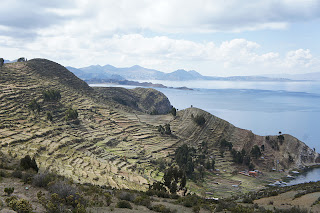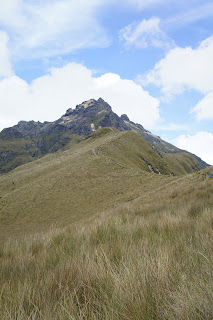I always feel a certain amount of nervous excitement before setting off for a summit, but with Pequeno Alpamayo this was amplified somewhat. This little peak of 5425m was going to be more technical than anything else I’d done before. I had done lots of homework on it and taken impartial, expert advice to make sure as far as possible, that it was within my capabilities. I was also in pretty good shape, (there is always plenty of room for improvement where I am concerned) having summited 5 mountains in the last 4 months and done plenty of trekking. I’ve also been at altitude for some considerable time now, so that wasn’t going to be a problem.
Why was I nervous? I have a confession.
I’m scared of heights.
Well not exactly scared of heights, scared of falling. There’s a big difference. I’ve also managed over the last 18 months to overcome this fear to quite an extent. It is both rational, given the activities I’m doing, and irrational at the same time. The suddenness with which the fear can grip and immobilise is scary. I didn’t want this to happen half way up a steep icy wall.
I had done as much as I could with checking the credentials of the agency and guide and Id also managed to find a climbing partner, a German lady called Lillian and then finally there was the equipment.
We were taken to the equipment store on the morning of departure. (Mental note, always check this before).
I wasn’t impressed by what the agency had to offer. Most of it was tatty and dirty. I have to say, this wasn’t a good start. I have all my own decent mountain clothing and once I selected some plastic boots I managed to find some decent crampons and a harness. It wasn’t helping with my nerves, the fact that the equipment was questionable. At least I had a bit of a clue in what to choose. It was only the fact that the guide was so nice and professional that I didnt bail out at this point. This is a reflection on the guide (Felix) and not the agency.
We set off for the mountains, up out of La Paz and towards the Condoriri range. Heading out along the straight road through El Alto the city disappears behind us and the road is lined on one side with the mountains. The land around is shades of brown, flat, infertile. There are mud brick dwellings scattered like cubes in the dirt. People live here. There are not much signs of life. The odd animal and person scratching around in the dirt, the odd piece of earth dug into furrows and planted. The owners trying to coax some type of sustenance out of this barren land.
After an hour or so of bumping along a dirt track we arrive at a couple of houses near the foothills. Here they have donkeys, which are loaded up with our tents and food and we begin our trek into the mountains.
Our camp is the Wasi Condoriri campsite. There is one other tent. There is a hosepipe coming from the ground spouting fresh water and some little toilet huts dotted about. Felix told us that in high season it not uncommon to have 80 to 100 people here. I’m glad its low season. We are surrounded on one side by various peaks of the Condoriri range.
After an early dinner we go to bed and wake up at 3am to start our hike to the glacier. In the dark and at a distance the glacier looks like a sheer wall in front of us. The first section is old and dirty from dust, its surface scared and pocked. Eventually we are onto the pristine white slopes of Pico Tarija, 5300m. We must summit Tarija in order to get to Pequeno Alpamayo. The hike to the top of Tarija is a fairly easy 3 hours. The sun is up when we arrive and the sky is blue. We can now see Pequeno Alpamayo clearly for the first time. It’s a very aesthetically pleasing mountain to look at, with a clear ridge line in 3 distinct sections up to a pretty snow cone summit.
I can do this, I thought.
We sat on the summit of Tarija for about 20 minutes, having a snack and taking off our crampons. I could see ahead of us, the occupants of the other tent. They were on the second section of the ridge of Pequeno Alpamayo, when I saw them heading over the edge, on purpose. They were taking the difficult route. They had no ropes or other protection than their ice axes and crampons and were free ice climbing on slopes of 85 degrees, spider men like towards the summit. It was scary to watch. I was glued to the spot until I saw they had both made it up safely. Crazy.
We had a steep scramble down the other side of Tarija, about 50 meters to a ridge line that connected us with the start of Alpamayo. Then the fun began. Felix went ahead of us and fixed protection into the ice, clipped us in on the rope, and we went up. Section by section. The last two sections seemed very steep and although only a maximum of 60 degrees, when you are on an icy ridge, it feels like 90! We had to use the front spikes of our crampons and our ice axes to haul ourselves slowly up the slope. It was really hard work! Finally we made it to the top. It was warm but the cloud was coming in fast and the visibility suddenly got poor. I was happy to be at the summit, really happy, but I was worried about getting down.
Our decent was epic. Partly due to the fact that we were starting to feel a bit tired and partly due to the fact that a storm had blown up, with was snowing and there were great claps of thunder around us. I could tell Felix wanted us down as quickly as possible. It was harder than the way up. The snow and ice was softer, making it difficult of get good grip on the icy slopes, and the visibility was now really bad. Section by section we made it back to Tareja and started back down the glacier to the camp.
It had taken us six and a half hours from the camp to the summit, it took us 5 to get back due to the weather conditions. Never did a cup of tea taste so good!
You might ask why I do this. I ask myself sometimes when Im staring down a deep crevasse which must be jumped, fear in the pit of my stomach. The only answer is it makes me feel alive, the adrenalin, its like an addiction.











































